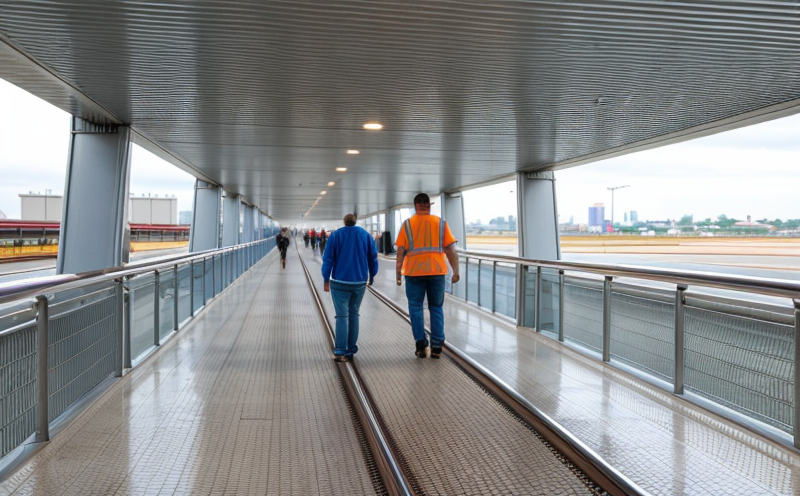Moving walkway handrail inspection
The inspection of moving walkway handrails is a critical component in ensuring public safety and compliance with international standards. This service focuses on the structural integrity, functionality, and aesthetic quality of handrails that are part of moving walkways or escalators. Quality managers, compliance officers, R&D engineers, and procurement professionals rely on this inspection to maintain regulatory adherence and operational reliability.
The primary objective is to assess whether the handrail meets specific design specifications and ensures it operates safely under various conditions. This includes checking for any signs of wear and tear, corrosion, or damage that could compromise safety. The service typically involves a detailed visual examination, followed by more in-depth testing using specialized equipment.
For instance, the inspection might include evaluating the grip quality, ensuring it is non-slippery, and verifying its durability against everyday use. Compliance officers need to ensure these inspections are conducted regularly to meet local and international standards. R&D engineers can also benefit from detailed insights into potential improvements or design modifications based on historical inspection data.
The process begins with a comprehensive review of the moving walkway's design specifications, including the materials used for the handrails. This helps in identifying any potential vulnerabilities that could lead to safety issues. Following this, field engineers conduct an on-site assessment, focusing on areas where wear and tear are most likely to occur.
During the inspection, engineers use a variety of tools such as rulers, calipers, and specialized meters designed for measuring surface roughness and friction coefficients. They also employ advanced imaging techniques like ultrasonic testing or radiography if necessary to detect internal defects that might not be visible on the surface. Reporting is done comprehensively, detailing any issues found along with recommendations for corrective actions.
Regular inspections are crucial because they help prevent accidents caused by malfunctioning handrails. For example, a slip-resistant surface can significantly reduce the risk of falls, especially in high-traffic areas where elderly individuals or people using mobility aids frequent these facilities.
The moving walkway handrail inspection plays a vital role in maintaining public safety and operational efficiency. By adhering to strict standards and conducting thorough inspections, we ensure that each facility operates safely and meets all regulatory requirements.
Applied Standards
The moving walkway handrail inspection is guided by several international standards designed to ensure safety and quality. Key among these are:
- ISO/TS 18735:2019 – This standard provides guidelines on the design, construction, installation, operation, maintenance, and decommissioning of moving walkways.
- ASTM F2642-17 – Focuses specifically on the requirements for handrails used in moving walks and people movers.
- EN 1059:2018 – Covers all aspects of moving walkways, including the design and construction of handrails.
These standards provide a framework for conducting thorough inspections that cover all critical areas. They ensure that every element of the moving walkway handrail is checked against industry best practices, enhancing safety and reliability.
International Acceptance and Recognition
- The inspection service for moving walkway handrails has gained international recognition. Standards like ISO/TS 18735:2019 are widely accepted in countries across Europe, North America, Asia, and Australia.
- ASTM F2642-17 is utilized by facilities in the United States and Canada, ensuring compliance with local regulations while aligning with global best practices.
- The European Norm EN 1059:2018 enjoys a high level of acceptance within the European Union, providing a harmonized approach to moving walkway safety standards across member states.
These international accreditations and recognitions underscore the importance of adhering to these standards. They ensure that inspections are performed consistently and effectively, meeting the highest levels of quality and safety worldwide.
Use Cases and Application Examples
The moving walkway handrail inspection is applicable in various settings where public safety and compliance with international standards are paramount. Here are some specific use cases:
- Airports: At airports, the inspection ensures that passengers can navigate through crowded areas safely, especially during peak travel times.
- Hospitals: In hospitals, moving walkways provide a convenient way for staff and visitors to move around quickly, reducing the risk of accidents in busy environments.
- Shopping Malls: Shopping malls benefit from safer walking experiences for customers, enhancing overall satisfaction and safety.
- Rail Stations: Rail stations use these inspections to maintain smooth passenger flow, improving efficiency and reducing the risk of accidents in transit hubs.
Each application highlights the importance of maintaining high standards of safety and reliability. By adhering to international standards, facilities can ensure that their moving walkways operate safely and efficiently, thereby enhancing public confidence and trust.





